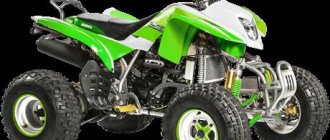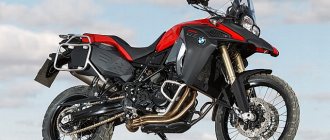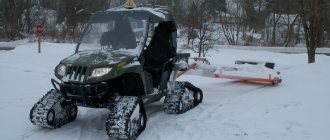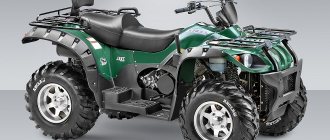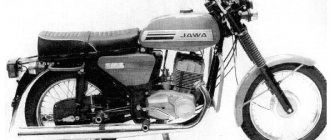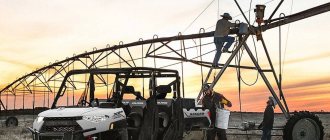Snowmobiles from the Canadian brand BRP Lynx are popular all over the world. The brand's products are characterized as ultra-modern devices designed specifically for use in the harsh snowy conditions of Russia and Europe. BRP Lynx snowmobiles are characterized by reliability, fuel efficiency, the highest build quality, dynamism and interesting design.
The Finnish brand Lynx, which began producing equipment in 1968, was in decline for a long time and produced products that were not in demand. The situation changed after the company was bought by the BRP concern. Canadian investment and management have taken the brand to a whole new level. Now BRP Lynx snowmobiles are considered the standard in their segment and meet international standards. Most of the company's products are aimed at the domestic market. There are more and more BRP Lynx dealers in Russia, but the share of Finnish snowmobiles still remains small.
BRP Lynx Yeti Pro Army V-800 (“Army Man”) is a powerful utilitarian multi-purpose snowmobile, originally designed for the army. Unpretentiousness and simplicity make the model an ideal option for hunters, fishermen and people who prefer extreme travel. The device is capable of transporting loads weighing up to 329 kg over snow-covered hills or areas inaccessible to other snowmobiles. The model is suitable for movement in any conditions and in any weather. Wide footrests, a comfortable seat and heated steering wheel grips make traveling on the device as comfortable as possible.
Video
The BRP Lynx Yeti Pro Army V-800, built on the Yeti II platform, is the “big brother” of the popular Yeti Pro 550 series. The appearance of the models is almost identical, but in the engine compartment of the “army” version there is a more powerful motor created specifically for this device . The unit settings are focused on traction, which allows the equipment to carry a sled with large luggage or pull small cars out of the snow.
Pro Army was conceived as a snowmobile for extreme conditions of movement. In addition to the standard options for such models (high windshield, heated grips, tow bar, trunk, downshift), the basic package includes a spare set of spark plugs and a variator belt. The car received 2 batteries at once, ensuring the engine starts at the lowest temperatures. The radiators of the cooling system duplicate each other in their functionality. The first is located in the engine compartment and is cooled by air flow, the second is installed above the track. The main load falls on the last radiator. The standard package also includes a sealed bag for documents or maps, an axe, a tow rope, a knife and a set of spare lamps. A sealed case is installed on the lattice trunk. All this makes the basic equipment of this snowmobile one of the richest in its class.
The BRP Lynx Yeti Pro Army V-800 represents the Super Wide Track category and is one of the leaders in its class in most respects.
Hard workers
Engine: 2-cylinder, in-line, 2-stroke, 535 cm3, 46 hp.
Ski track: 960 mm Track size (LxWxH): 3968 x 508 x 25 mm Dry weight: 291 kg Price**: RUB 283,000 Engine: 2-cylinder, in-line, 2-stroke, 535 cm3, 46 hp. Ski track: 960 mm Track size (LxWxH): 3968 x 508 x 25 mm Dry weight: 291 kg Price**: RUB 283,000
Viking III is perhaps the most balanced “price-quality-comfort” utility from the “three tuning forks”. Unlike the truly spartan BR250T, everything in this device is truly mature, from the engine to the equipment. A two-cylinder engine of more than half a liter capacity produces 46 horsepower, although modest, but quite acceptable for ordinary household tasks, and the variator, in addition to reverse, is also equipped with a reduction range. Plus a wide track with good grip, allowing you to move through snow of any depth with maximum load - all this makes the Viking III an ideal working machine for any task. It can become a multifunctional transport at a ski resort, a shuttle for oil workers in the Arctic, and an excellent assistant for hunters.
In addition to quite acceptable dynamics and towing potential, the Viking III does not shy away from comfort. There is nothing superfluous in it, but it has everything you need for comfortable everyday work for many hours. Of course, there is already electric start, heated steering wheel grips, and a backrest for the passenger. The basic package includes a towbar and a luggage rack. The suspension also contributes to rider comfort: the skis are mounted on telescopic struts, and the ProAction Plus rear suspension with a high-pressure gas-filled shock absorber and the ability to quickly adjust spring preload and rebound damping is generally considered one of the best in the world. In short, the Viking III is a truly universal device: it can not only perform complex work in any weather conditions, but also become an excellent tool for traveling or riding, because for it comfort is not an empty phrase.
Polaris. This American company was one of the first to start selling its equipment in Russia. That is why its snowmobiles are, perhaps, more often than others found in the snowy expanses of our homeland. Both amateurs and professionals appreciated their quality and reliability. According to many experts, it is Polaris that is most suitable for operation in Russian conditions. The reason is not only the reliability and unpretentiousness of the equipment, but also the availability of spare parts, and not only original ones. In neighboring Finland, for example, Polaris snowmobiles are so popular that a whole industry has emerged around them, offering not only all kinds of tuning and accessories, but also a full range of spare parts. This, of course, speeds up and reduces the cost of any repair, since spare parts are much closer to transport. According to the traditional classification, snowmobiles designed for movement in deep snow are called Wide Track; the main feature of this type of equipment is a wide track. Polaris utility vehicles bear exactly this name, but in a slightly modified form.
WIDETRAK LX
Element characteristics:
Chassis:
- front suspension type – telescopic (LTS);
- front suspension shock absorbers – HPG 30;
- front suspension travel – 150 mm;
- rear suspension type – XWLS;
- rear suspension shock absorbers – HPG 36;
- rear suspension travel – 210 mm;
- ski type – ADJ (plastic linings).
Transmission:
- variator drive pulley – TRA IV;
- variator driven pulley – NDT 6K VSA;
- reverse – mechanical.
"Tourist" Ski-Doo Legend Touring V-800
Actually, the main purpose of this snowmobile is accurately described in the name: it is a famous model, maximally adapted for long-distance travel. Engineers at Bombardier Recreational Products call it "the perfect choice for safari."
The snowmobile is built on the RF aluminum platform, the prototype of which, in turn, was the “sports” REV chassis. Its main feature is the location of the engine in the base, behind the front suspension. This design made it possible to reduce the load on the skis, place a fairly large 800 cc engine as compactly as possible and, ultimately, improve the handling of the snowmobile. This arrangement was once tested on the REV platform of sports snowmobiles and, having confirmed its effectiveness, began to be used on the “mass” RF chassis.
The front suspension here is based on A-arms with swinging bars (for better maneuverability and control over the car). At the rear there is SC-136 type suspension with HPG shock absorber.
Well, the Rotax V-800 engine suited this model perfectly, increasing traction characteristics and significantly improving the range on one fill-up.
Engine
The BRP Lynx Yeti Pro Army V-800 snowmobile is equipped with a modern 4-stroke V-shaped Rotax V-810 engine with 1 overhead camshaft.
Unit characteristics:
- working volume – 799.9 cc;
- rated power – 49 (65) kW (hp);
- compression ratio – 10.3:1;
- number of cylinders – 2;
- cylinder diameter – 91 mm.
Engine Features:
- cooling system – liquid;
- lubrication system - wet sump (a replaceable BRP Rotax paper filter is used as an oil filter);
- exhaust system - spark arrestor (USDA certified);
- air filter – synthetic (foam rubber and paper);
- number of valves – 8 (mechanical pushers).
Innovations that appeared in the Rotax V-810 engine:
- Long Block for the unit (camshaft chain guide has been modernized);
- new chain tensioner guide. Thanks to improved design and materials, element wear is reduced. The guide is made of steel and covered with rubber. When heated, deformation does not occur, therefore the stretch of the timing chain is reduced, and the service life becomes longer. The guide is installed only on the chain tensioner side.
The snowmobile's fuel tank is designed for 42 liters, the oil tank is designed for 2.8 liters.
Hard workers
WIDETRAK LX Engine: 2-cylinder, in-line, 2-stroke, 488 cm3, 85 hp.
Ski track: 965 mm Track size (LxWxH): 3962 x 508 x 25 mm Dry weight: 278 kg Price**: RUB 313,000 WIDETRAK LX Engine: 2-cylinder, in-line, 2-stroke, 488 cm3, 85 hp. Ski track: 965 mm Track size (LxWxH): 3962 x 508 x 25 mm Dry weight: 278 kg Price**: RUB 313,000
This model is the most affordable in the company's line of utilitarian snowmobiles. But, unlike Yamaha, the “American” does not at all pretend to be a “gray mouse”, both externally and internally. The peculiarities of the national character are reflected. After all, Americans manage to make even such prosaic things as long-distance trucks and tractors beautiful - just remember Mack tractors. The picture is the same with snowmobiles: Widetrak LX, although the youngest, looks very daredevil. It is immediately clear that not only layout engineers, but also designers worked on the appearance of the car. Although this is not the main advantage of a utilitarian car, it is still nice. As for the main thing, everything is in perfect order here with Polaris: with an engine displacement that is 50 cm3 smaller than that of the Yamaha Viking III, the power of the “American” is almost twice as high - 85 hp. First of all, this is achieved by installing a separate carburetor for each cylinder. Due to the large power supply, the engine was also equipped with a liquid cooling system. For the same reason, a mechanical brake is no longer enough here - it is hydraulic.
The CVT transmission is equipped with reverse and a reduction range, which significantly expands the possibilities of both movement in difficult conditions and transportation of loaded sleds. This is where the Widetrak LX and Viking III are twin brothers. And their “shoes” are practically the same size: the width of the caterpillar “half a meter” allows you to move through snowdrifts of any depth. And thanks to its power, the LX is even capable of pulling a car out of a ditch, something the “Japanese brother” can hardly boast of.
Match the engine and suspension. The Americans did not skimp on comfort: the skis are mounted on a modern IFS lever suspension, and the rear adjustable suspension with articulated extension has two shock absorbers - front and rear. Of course, the Yankees did not forget about the much-needed “utilities”, such as a lattice trunk at the rear, a large underseat space for luggage and a towbar. The passenger seat is equipped with an adjustable backrest, and the steering wheel handles and gas trigger are heated. The basic package even includes a 12 V socket.
In a word, this device can already be considered fully universal. Even if you go into the forest for firewood, even if you drag a dead bear on a sleigh, or if you want to take the girls around the dacha with the wind, and even your snowmobile friends won’t shy away from you.
BRP-Lynx
The once Finnish brand Lynx, although a fairly old player in the snowmobile market (the first snowmobile under this brand was released in 1968), until recently was in approximately the same “health” as domestic manufacturers. Morally and technically outdated models, appalling build quality... the flow of complaint equipment entering the factory gates was not much less than the flow coming off the assembly line. The situation changed dramatically when the brand, with all its production and engineering innards, was bought by the BRP concern. Effective quality control and highly qualified management have raised the brand to a new level. Now Lynx snowmobiles meet the best world standards. True, the brand is focused mainly on the domestic market of Finland, and although official BRP dealers operate in Russia, selling, of course, Finnish equipment, its share in our market is small.
Yeti Pro 550
Owner reviews
- Kevin: I purchased the BRP Lynx Yeti Pro Army V-800 at the beginning of the year. I only managed to ride it a few times. I liked that the engine is very quiet in all modes and speeds, while the torque and dynamics always remain at the same level, regardless of the number of cargo and passengers (even three of us rode on a snowflake). The device does not feel the load, and the suspension does not show any signs of breaking when fully loaded. Consumption is less than 15 liters per 100 km, which is very good. At a temperature of -30 degrees, the snowmobile started up the first time. I didn’t find any downsides to the technology, except for one thing – the price. The conclusion about the Yeti Pro Army V-800 is this: if you have the money, then you should buy this device.
- Fedor, Kazan: Any extreme and powerful technique is not a cheap pleasure. When I was choosing a snowmobile for myself, I thought for quite a long time. I was sorry for the money, but still decided to buy the BRP Lynx Yeti Pro Army V-800. I bought a used model, so I managed to save a little money. The device is suitable if you need to carry a sled with a large load. In deep snow, he carried me with my brother and a sled with 200 kg of luggage without strain. There were cases when the device failed (due to the large mass and high center of gravity), but this did not happen often. I was pleased with the consumption - approximately 12.2 liters per hundred. In terms of reliability and efficiency, I have not yet seen a better Yeti Pro Army V-800.
- Konstantin, Krasnoyarsk: I bought the BRP Lynx Yeti Pro Army V-800 last year and immediately started using it. I really liked the snowmobile during the run-in, but when I move at high speed, vibration is felt. It’s still unclear where it came from; I haven’t contacted the service. The fan also turns on frequently, the overheating light has never come on. The steering of the snowmobile is very comfortable, but heavy. At first my hands were very tired, but then I got used to it. In terms of stability, there are questions, I almost knocked over the equipment 2 times. I like the traction in low gear, the device carries absolutely any load. The trunk is huge. I'm happy with the snowmobile.
- Valentin_1992: In less than two winters I drove almost 7,000 km on the Army Yeti. In terms of fuel consumption, everything is fine. Even when fully loaded, it comes out to no more than 20-24 l/100 km. A snowmobile has its pros and cons. In cold weather the engine starts perfectly (even at -42 degrees). The cross-country ability is quite good, the snowflake itself is a real “workhorse” that can be used every day. The device is a bit heavy, they say there are problems with the engine, but so far these shortcomings do not particularly bother me.
Hard workers
This device is the undoubted class leader, primarily in terms of price. Bravo - that's its full name - appeared back in 1992 and has been produced almost unchanged since then. His credo is modesty, conciseness and simplicity. A single-cylinder two-stroke air-cooled engine, the simplest suspension (springs and shock absorbers in the front and a spring-loaded slide with a shock absorber in the rear), the absence of electric start and reverse gear, a mechanical drive of the disc brake - everything is aimed at simplifying, lightening and reducing the cost of the car.
In literally all characteristics, except perhaps power, Bravo can be put on a par with products from domestic manufacturers. The only striking difference between the “Japanese” and the “Nasheprom” products is the quality of workmanship and reliability. Even the very first argument of many supporters of domestic products: “But it breaks, so what to do? And “Buran” I can fix in any snowdrift ...” in this case does not work, because the design of the “bateshka” is perhaps even simpler than the same “Lynx” or “Buran”.
The lack of reverse in the transmission is somewhat surprising, but one glance at the figure of the curb weight of the device (and this is only 200 kg) removes the question: if something happens, you can turn it around with the handles. The rather narrow track of the skis and the primitive suspension make energetic driving almost impossible; the device strives to end up “upward with its fins” in any more or less steep turn and even catching a snow bump that seems insignificant at first glance. But even this shortcoming in the framework of a simple utilitarian approach should not be considered as such. If you want to "burn" - if you please, the device is three times more expensive.
Of course, Bravo is far from a record holder in terms of traction and dynamic characteristics. The declared maximum speed is only 70 km/h, and you can’t attach a sled with hundreds of kilograms of luggage - it won’t pull it out. But it’s difficult to find a more suitable car, say, for going fishing or patrolling ranger grounds.
VK540III



